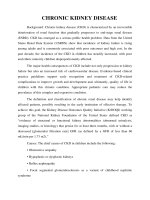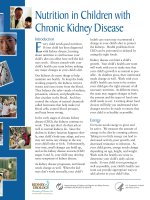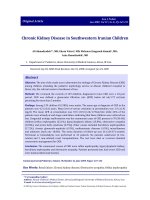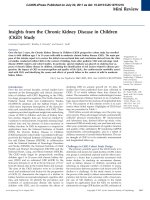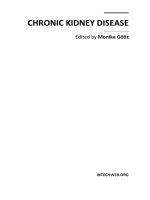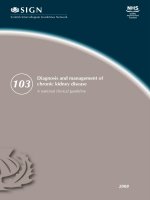For Chronic Kidney Disease: Evaluation, Classification and Stratification doc
Bạn đang xem bản rút gọn của tài liệu. Xem và tải ngay bản đầy đủ của tài liệu tại đây (7.05 MB, 356 trang )
CLINICAL PRACTICE
GUIDELINES
CLINICAL PRACTICE GUIDELINES
K/DOQI
For Chronic Kidney Disease:
Evaluation, Classification
and Stratification
For Chronic Kidney Disease
ISBN 1-931472-10-6
NKF Order No. K/DOQI-156
Amgen Part No. P35181
K/DOQI Learning System (KLS)™
30 East 33rd Street
New York, NY 10016
Phone 800 622-9010
www.kidney.org
Made possible through an educational grant from Amgen,
Founding and Principal Sponsor of NKF-K/DOQI.™
Additional implementation support was received from Ortho Biotech
Products, L.P. and Bayer Diagnostics.
Clinical Practice
Guidelines
For Chronic
Kidney Disease:
Evaluation,
Classification and
Stratification
K/DOQI Disclaimer
These guidelines are based upon the best information available at the time of publica-
tion. They are designed to provide information and assist decision making. They are
not intended to define a standard of care, and should not be construed as doing so.
Neither should they be interpreted as prescribing an exclusive course of management.
Variations in practice will inevitably and appropriately occur when clinicians take
into account the needs of individual patients, available resources, and limitations
unique to an institution or type of practice. Every healthcare professional making use
of these guidelines is responsible for evaluating the appropriateness of applying them
in the setting of any particular clinical situation.
The recommendations for research contained within this document are general
and not meant to imply a specific protocol.
G
ENERAL
A
CKNOWLEDGEMENTS
The NKF gratefully acknowledges the support of Amgen, Inc., Founding and Principal
Sponsor of K/DOQI.
We also thank Bayer Diagnostics and Ortho Biotech Products, L.P., K/DOQI Imple-
mentation Partners.
NKF-DOQI and K/DOQI are trademarks of the National Kidney Foundation, Inc.
In citing this document, please refer to the original source as follows:
National Kidney Foundation. K/DOQI Clinical Practice Guidelines for Chronic Kid-
ney Disease: Evaluation, Classification and Stratification. Am J Kidney Dis 39:S1-S266,
2002 (suppl 1)
These Guidelines, as well as all other K/DOQI guidelines, can be accessed on the
Internet at: www.kdoqi.org
᭧ 2002 National Kidney Foundation, Inc.
ISBN 1-931472-10-6
All Rights Reserved.
No part of this publication may be reproduced or transmitted in any form or by
any means, electronic or mechanical, including photocopy, recording, or any
information storage retrieval system, without permission in writing from the National
Kidney Foundation, Inc.
National Kidney Foundation, Inc.
30 E. 33
rd
Street
New York, NY 10016
212-889-2210
ii National Kidney Foundation K/DOQI
Chronic Kidney Disease
Work Group and Evidence Review Team Membership
Andrew S. Levey, MD, Chair
New England Medical Center
Boston, MA
Josef Coresh, MD, PhD, Vice Chair
Johns Hopkins Medical Institutions
Baltimore, MD
Adult Work Group Members
Kline Bolton, MD, FACP John Kusek, PhD
University of Virginia Hospital National Institutes of Diabetes and
Charlotesville, VA Digestive and Kidney Diseases
Bethesda, MD
Bruce Culleton, MD
Foothills Hospital, University of Adeera Levin, MD, FRCP
Calgary St. Paul’s Hospital
Calgary, Alberta Vancouver, British Columbia
Canada Canada
Kathy Schiro Harvey, MS, RD, CSR Kenneth L. Minaker, MD
Puget Sound Kidney Center Massachusetts General Hospital
Mountlake Terrace, WA Boston, MA
T. Alp Ikizler, MD Robert Nelson, MD, PhD
Vanderbilt University Medical Center National Institutes of Diabetes and
Nashville, TN Digestive and Kidney Diseases
Phoenix, AZ
Cynda Ann Johnson, MD, MBA
University of Iowa Helmut Rennke, MD
Iowa City, IA Brigham & Women’s Hospital
Boston, MA
Annamaria Kausz, MD, MS
New England Medical Center Michael Steffes, MD, PhD
Boston, MA University of Minnesota
Minneapolis, MN
Paul L. Kimmel, MD
National Institutes of Diabetes and Beth Witten, MSW, ACSW, LSCSW
Digestive and Kidney Diseases Witten and Associates, LLC
Bethesda, MD Overland Park, KS
K/DOQI National Kidney Foundation iii
Pediatric Work Group Members
Ronald J. Hogg, MD, Chair
Medical City Hospital
Dallas, TX
Susan Furth, MD, PhD Ronald J. Portman, MD
Johns Hopkins University University of Texas Health Sciences
Baltimore, MD Center—Houston
Houston, TX
Kevin V. Lemley, MD, PhD
Stanford University School of Medicine George Schwartz, MD
Stanford, CT University of Rochester School of Medicine
Rochester, NY
Evidence Review Team
Joseph Lau, MD, Director
New England Medical Center
Boston, MA
Ethan Balk, MD, MPH, Assistant Director
New England Medical Center
Boston, MA
Ronald D. Perrone, MD Priscilla Chew, MPH
Tauqeer Karim, MD Brad C. Astor, PhD, MPH
Lara Rayan, MD Deirdre DeVine, MLitt
Inas Al-Massry, MD
K/DOQI Support Group
Garabed Eknoyan, MD, Co-Chair
Baylor College of Medicine
Houston, TX
Nathan Levin, MD, FACP, Co-Chair
Renal Research Institute
New York, NY
Sally Burrows-Hudson, RN Donna Mapes, DNSc, RN
William Keane, MD Edith Oberley, MA
Alan Kliger, MD Kerry Willis, PhD
Derrick Latos, MD, FACP
iv National Kidney Foundation K/DOQI
K/DOQI Advisory Board Members
Garabed Eknoyan, MD, Co-Chair
Baylor College of Medicine
Houston, TX
Nathan Levin, MD, FACP, Co-Chair
Renal Research Institute
New York, NY
George Bailie, PharmD, PhD Sally McCulloch, MSN, RN, CNN
Gavin Becker, MD, MBBS Maureen Michael, BSN, MBA
Jerrilynn Burrowes, MS, RD, CDN Joseph V. Nally, MD
David Churchill, MD, FACP John M. Newmann, PhD, MPH
Allan Collins, MD, FACP Allen Nissenson, MD
William Couser, MD Keith Norris, MD
Dick DeZeeuw, MD, PhD William Owen, Jr., MD
Alan Garber, MD, PhD Thakor G. Patel, MD, MACP
Thomas Golper, MD Glenda Payne, MS, RN, CNN
Frank Gotch, MD Rosa A. Rivera-Mizzoni, MSW,
Antonio Gotto, MD LCSW
Joel W. Greer, PhD David Smith
Richard Grimm, Jr., MD Robert Star, MD
Ramon G. Hannah, MD, MS Michael Steffes, MD, PhD
Jaime Herrera Acosta, MD Theodore Steinman, MD
Ronald Hogg, MD Fernando Valderrabano, MD, PhD
Lawrence Hunsicker, MD John Walls, MB, FRCP
Cynda Ann Johnson, MD, MBA Jean-Pierre Wauters, MD
Michael Klag, MD, MPH Nanette Wenger, MD
Saulo Klahr, MD
Ex-Officio
Caya Lewis, MPH
Josephine Briggs, MD
Edmund Lowrie, MD
Arthur Matas, MD
K/DOQI National Kidney Foundation v
K/DOQI
C
LINICAL
P
RACTICE
G
UIDELINES
FOR
C
HRONIC
K
IDNEY
D
ISEASE:
E
VALUATION
C
LASSIFICATION AND
S
TRATIFICATION
Table of Contents
Tables viii
Figures xiii
Acronyms and Abbreviations xvii
Foreword xxiii
Part 1. Executive Summary 1
Part 2. Background 23
Part 3. Chronic Kidney Disease as a Public Health Problem 29
Part 4. Definition and Classification of Stages of Chronic Kidney Disease
Guideline 1. Definition and Stages of Chronic Kidney Disease 43
Guideline 2. Evaluation and Treatment 66
Guideline 3. Individuals at Increased Risk of Chronic Kidney Disease 75
Part 5. Evaluation of Laboratory Measurements for Clinical
Assessment of Kidney Disease
Guideline 4. Estimation of GFR 81
Guideline 5. Assessment of Proteinuria 100
Guideline 6. Markers of Chronic Kidney Disease Other Than Proteinuria 112
Part 6. Association of Level of GFR With Complications in Adults
Guideline 7. Association of Level of GFR With Hypertension 124
Guideline 8. Association of Level of GFR With Anemia 136
Guideline 9. Association of Level of GFR With Nutritional Status 145
Guideline 10. Association of Level of GFR With Bone Disease and
Disorders of Calcium and Phosphorus Metabolism 163
Guideline 11. Association of Level of GFR With Neuropathy 180
Guideline 12. Association of Level of GFR With Indices of Functioning
and Well-Being 186
Part 7. Stratification of Risk for Progression of Kidney Disease and Development
of Cardiovascular Disease
Guideline 13. Factors Associated With Loss of Kidney Function in Chronic
Kidney Disease 197
Guideline 14. Association of Chronic Kidney Disease With Diabetic
Complications 230
Guideline 15. Association of Chronic Kidney Disease With Cardiovascular
Disease 238
K/DOQI National Kidney Foundation vii
Part 8. Recommendations for Clinical Performance Measures 251
Part 9. Approach to Chronic Kidney Disease Using These Guidelines 255
Part 10. Appendices
Appendix 1. Methods for Review of Articles 265
Appendix 2. Kidney Function and Associated Conditions in the
United States: Methods and Findings From the Third National Health and
Nutrition Examination Survey (1988 to 1994) 279
Appendix 3. Methodological Aspects of Evaluating Equations to Predict
GFR and Calculations Using 24-Hour Urine Samples 283
Part 11. Work Group Members 287
Part 12. Acknowledgements 295
Bibliography 299
Tables
Table 1 Goals of the CKD Work Group 2
Table 2 Definition of Chronic Kidney Disease 3
Table 3 Stages of Chronic Kidney Disease: A Clinical Action Plan 4
Table 4 Stages and Prevalence of Chronic Kidney Disease (Age Ն20) 5
Table 5 Potentially Modifiable Risk Factors for Development
and Progression of Chronic Kidney Disease According to Stage 7
Table 6 Approach to the Evidence Review 7
Table 7 Published Guidelines and Recommendation for Chronic
Kidney Disease 27
Table 8 Questions and Methods 30
Table 9 Types of Risk Factors for Adverse Outcomes of Chronic
Kidney Disease 32
Table 10 Stages of Chronic Kidney Disease 44
Table 11 Definition of Chronic Kidney Disease 44
Table 12 Definition and Stages of Chronic Kidney Disease 45
Table 13 Prevalence of GFR Categories: NHANES III 1988–1994
US Adults Age Ն20 47
Table 14 Prevalence of Stages of Chronic Kidney Disease and Levels
of Kidney Function in the US 47
Table 15 Definitions of Proteinuria and Albuminuria 49
Table 16 Albumin Excretion Rate: Normal Range in Children 50
Table 17 Urine Albumin-to-Creatinine Ratio: Normal Range in Children 51
Table 18 Prevalence of Albuminuria in Adults: NHANES III 52
Table 19 Prevalence of Albuminuria by Age Group: NHANES III 52
Table 20 Prevalence of Albuminuria Among Individuals With a History of
Diabetes: NHANES III 53
Table 21 Prevalence of Albuminuria Among Individuals Without a
History of Diabetes: NHANES III 53
viii National Kidney Foundation K/DOQI
Table 22 Proteinuria: Prevalence in Nondiabetic Children 54
Table 23 Albuminuria: Prevalence in Nondiabetic Children 54
Table 24 Normal GFR in Children and Young Adults 55
Table 25 Normal GFR in Adults Extrapolated From Data in 72 Healthy Men 56
Table 26 Prevalence of GFR Categories in Adults 57
Table 27 Description of MDRD Study Participants Who Developed Kidney
Failure: Kidney Function 61
Table 28 Description of MDRD Study Participants Who Developed Kidney
Failure: Dietary Intake and Nutritional Status 62
Table 29 Comparison of Kidney Function Measurements in MDRD Study
Participants Who Developed Kidney Failure 62
Table 30 GFR at Start of Hemodialysis 63
Table 31 Creatinine Clearance at Start of Hemodialysis 64
Table 32 Serum Creatinine at Start of Hemodialysis 64
Table 33 Stages of Chronic Kidney Disease: A Clinical Action Plan 67
Table 34 Classification of Chronic Kidney Disease by Pathology, Etiology
and Prevalence in Patients With End-Stage Renal Disease 69
Table 35 Classification and Management of Comorbid Conditions in
Chronic Kidney Disease 70
Table 36 Association of Stages of Chronic Kidney Disease With
Complications 72
Table 37 Factors Linked With Noncompliance in Chronic Kidney Disease 73
Table 38 Classification of Risk Factors 76
Table 39 Types and Examples of Risk Factors for Chronic Kidney Disease 76
Table 40 Potential Risk Factors for Susceptibility to and Initiation
of Chronic Kidney Disease 77
Table 41 Relationship Between Types of Kidney Disease and Risk
Factors for Initiation and Susceptibility to Chronic
Kidney Disease 77
Table 42 Prevalence of Individuals at Increased Risk for Chronic
Kidney Disease 78
Table 43 Factors Affecting Serum Creatinine Concentration 87
Table 44 Equations Developed to Predict GFR in Adults Based on
Serum Creatinine 89
Table 45 Equations Developed to Predict GFR in Children Based on
Serum Creatinine 90
Table 46 Estimating GFR in Adults Using the Cockcroft-Gault Equation:
Accuracy and Bias 91
Table 47 Estimating GFR in Adults Using the MDRD Study Equation:
Accuracy and Bias 92
K/DOQI National Kidney Foundation ix
Table 48 Abbreviated MDRD Study Equation 92
Table 49 Serum Creatinine Corresponding to an Estimated GFR of 60 mL/min/
1.73 m
2
by the Abbreviated MDRD Study and Cockcroft-Gault
Equations 93
Table 50 Estimating GFR in Children Using the Schwartz Equation:
Accuracy and Bias 94
Table 51 Estimating GFR in Children Using the Counahan-Barratt or
Modified Counahan-Barratt Equations: Accuracy and Bias 95
Table 52 Clinical Situations in Which Clearance Measures May Be Necessary
to Estimate GFR 98
Table 53 Spot Urine Protein vs. Timed Urine Protein in Adults 104
Table 54 Spot Urine Albumin vs. Timed Urine Albumin in Adults 104
Table 55 Spot Urine Dipstick Albumin vs. Timed Urine Albumin in Adults 105
Table 56 Spot Urine Protein-to-Creatinine Ratio vs. Timed Urine Protein
in Adults 105
Table 57 Spot Urine Albumin-to-Creatinine Ratio vs. Timed Urine Albumin
in Adults 106
Table 58 Spot Urine Protein-to-Creatinine Ratio vs. Timed Urine Protein in
Nondiabetic Children 106
Table 59 Spot Urine Albumin-to-Creatinine Ratio vs. Timed Urine Albumin
in Children 107
Table 60 Comparison of Methods for Urine Collection for Assessment of
Proteinuria 107
Table 61 Common Causes of False Results in Routine Measurements of Urinary
Albumin or Total Protein 108
Table 62 Interpretation of Proteinuria and Urine Sediment Abnormalities
as Markers of Chronic Kidney Disease 114
Table 63 Interpretation of Abnormalities on Imaging Studies as Markers of
Kidney Damage 115
Table 64 Clinical Presentations of Kidney Disease 116
Table 65 Relationship Between Types of Kidney Disease and Clinical
Presentations 117
Table 66 Retinol Binding Protein (RBP): Association With
Various Outcomes 119
Table 67 N-Acetyl-

-D-Glucosaminidase (NAG): Association With
Various Outcomes 119
Table 68

-2-Microglobulin (

-2-MG): Association With Various Outcomes 119
Table 69 Sodium Dodecyl Sulfate-Polyacrylamide Gel Electrophoresis
(SDS-PAGE): Association With Various Outcomes 119
Table 70 Urinary Cell Excretion: Association With Various Outcomes 120
Table 71 Classification of Blood Pressure for Adults Ն18 Years (JNC-VI) 126
x National Kidney Foundation K/DOQI
Table 72 Pathogenetic Mechanisms of High Blood Pressure in Chronic
Kidney Disease 127
Table 73 Association of Mean Arterial Pressure and Cardiovascular
Disease Events in Incident Dialysis Patients 129
Table 74 Recommended Research on High Blood Pressure in Chronic
Kidney Disease: Observational Studies 135
Table 75 Recommended Research on High Blood Pressure in Chronic
Kidney Disease: Clinical Trials 135
Table 76 Hemoglobin and Kidney Function 139
Table 77 Hematocrit and Kidney Function 140
Table 78 Erythropoietin Level and Kidney Function 142
Table 79 Ferritin and Kidney Function 143
Table 80 Miscellaneous Hematological Measures and Kidney Function 143
Table 81 Daily Calorie Intake and Kidney Function 150
Table 82 Daily Protein Intake and Kidney Function 150
Table 83 Serum Albumin and Kidney Function 153
Table 84 Serum Protein and Prealbumin and Kidney Function 154
Table 85 Transferrin and Kidney Function 155
Table 86 Serum Bicarbonate and Kidney Function 156
Table 87 Lipids and Kidney Function 157
Table 88 Body Mass Index and Kidney Function 159
Table 89 Ideal or Standard Body Weight and Kidney Function 159
Table 90 Body Tissue Composition (Muscle) and Kidney Function 160
Table 91 Body Tissue Composition (Fat) and Kidney Function 160
Table 92 Histologic Classification of Bone Lesions Associated With Kidney
Disease 165
Table 93 Parathyroid Hormone and Kidney Function 168
Table 94 Fractional Excretion of Phosphorus and Kidney Function 169
Table 95 Serum Calcium and Kidney Function 171
Table 96 Serum Phosphate and Kidney Function 174
Table 97 Vitamin D
3
and Kidney Function 177
Table 98 Bone Disease and Kidney Function 178
Table 99 Nerve Conduction Velocity and Kidney Function 182
Table 100 Miscellaneous Neurological Measurements and Kidney Function 183
Table 101 Autonomic Function and Kidney Function 184
Table 102 Domains of Functioning and Well-Being Measured by Specific
Instruments 187
Table 103 Symptoms and Health Perception and Kidney Function 189
Table 104 Physical Functioning and Kidney Function 190
Table 105 Mental Health, Depression, and Well-Being and Kidney Function 192
Table 106 Employment, Home Management, Recreation, and Pastimes and
Kidney Function 193
K/DOQI National Kidney Foundation xi
Table 107 Social Functioning and Kidney Function 193
Table 108 Functioning and Well-Being Measures 196
Table 109 Mean Rate of Decline of GFR for Various Causes of Kidney Disease 200
Table 110 Years Until Kidney Failure (GFR Ͻ15 mL/min/1.73 m
2
) Based on Level
of GFR and Rate of GFR Decline 202
Table 111 Kidney Disease Type as Predictor of Progression 205
Table 112 Black Race as a Predictor of Progression 206
Table 113 Low Baseline Kidney Function as a Predictor of Progression 207
Table 114 Male Gender as a Predictor of Progression 208
Table 115 Older Age as a Predictor of Progression 209
Table 116 Proteinuria or Albuminuria as Predictors of Progression 210
Table 117 Low Serum Albumin as a Predictor of Progression 211
Table 118 Blood Pressure as a Predictor of Progression 212
Table 119 Elevated HgbA
1c
as a Predictor of Progression 215
Table 120 Tobacco Use as a Predictor of Progression 216
Table 121 Dyslipidemia as Predictors of Progression 217
Table 122 Anemia as a Predictor of Progression 219
Table 123 Recommendations for Glycemic Control for People With Diabetes 220
Table 124 Risk Stratification and Indication for Antihypertensive Treatment 221
Table 125 Blood Pressure, Goals, Nonpharmacologic, and Pharmacologic
Therapy Recommended by the NKF Task Force on Cardiovascular
Disease in Chronic Renal Disease 222
Table 126 Research Classification of Diabetic Polyneuropathy 233
Table 127 Prevalence of Atherosclerotic Cardiovascular Disease According
to the Stage of Kidney Disease in Various Racial/Ethnic Groups With
Type 2 Diabetes 234
Table 128 Prevalence of Retinopathy According to the Stage of Kidney
Disease in Various Racial/Ethnic Groups With Type 2 Diabetes 236
Table 129 Guidelines and Position Statements on Care of Diabetic
Complications 237
Table 130 Traditional vs. Chronic Kidney Disease-Related Factors
Potentially Related to an Increased Risk for Cardiovascular Disease 240
Table 131 Lipoprotein Abnormalities in the General Population and in
Patients With Chronic Kidney Disease 242
Table 132 Decreased GFR as a Predictor of Cardiovascular Disease 242
Table 133 Decreased GFR as a Predictor of Mortality 243
Table 134 Proteinuria as a Predictor of Cardiovascular Disease 245
Table 135 Proteinuria as a Predictor of Cardiovascular Mortality 245
Table 136 Proteinuria as a Predictor of Total Mortality 246
Table 137 K/DOQI CKD Clinical Practice Guidelines and Performance
Measures 252
xii National Kidney Foundation K/DOQI
Table 138 Clinical Evaluation of Patients at Increased Risk of Chronic
Kidney Disease 256
Table 139 Stages of Chronic Kidney Disease: Clinical Presentations 257
Table 140 Simplified Classification of Chronic Kidney Disease by Diagnosis 257
Table 141 Clues to the Diagnosis of Chronic Kidney Disease From the
Patient’s History 258
Table 142 Laboratory Evaluation of Patients With Chronic Kidney Disease 259
Table 143 Stages and Clinical Features of Diabetic Kidney Disease 259
Table 144 Stages and Clinical Features of Nondiabetic Kidney Disease 260
Table 145 Stages and Clinical Features of Diseases in the Kidney Transplant 260
Table 146 Treatments to Slow the Progression of Chronic Kidney Disease
in Adults 261
Table 147 ‘‘Traditional’’ Risk Factors for Chronic Kidney Disease and Associated
Interventions 262
Table 148 Additional Clinical Interventions for Adults With GFR
Ͻ60 mL/min/1.73 m
2
263
Table 149 Clinical Evaluation of Elderly Individuals With GFR of
60–89 mL/min/1.73 m
2
263
Table 150 Evaluation of Studies of Prevalence 268
Table 151 Diagnostic Test Evaluation 269
Table 152 Evaluation of Clinical Associations 270
Table 153 Evaluation of Studies of Prognosis 271
Table 154 Literature Search and Review by Topic 273
Table 155 Format for Guidelines 277
Figures
Figure 1 Evidence Model for Stages in the Initiation and Progression of
Chronic Kidney Disease and Therapeutic Interventions 6
Figure 2 Incidence and Prevalence of End-Stage Renal Disease in the US 24
Figure 3 Evidence Model for Stages in the Initiation and Progression of
Cardiovascular Disease and Therapeutic Interventions 26
Figure 4 Kidney Function Decline in Chronic Kidney Disease 32
Figure 5 Creatinine Distribution: US Population Age Ն20 by Sex 36
Figure 6 Cardiovascular Mortality in the General Population (NCHS) and
in ESRD Treated by Dialysis (USRDS) 39
Figure 7 Prevalence of Albuminuria and High Blood Pressure (%) in US
Adults Age Ն20 Years, NHANES III, 1988–1994 46
Figure 8 Distribution of Albumin-to-Creatinine Ratio in US Men and
Women, Age Ն20 Years: NHANES III, 1988-1994 49
Figure 9 GFR vs. Age 56
Figure 10 Percentiles of GFR Regressed on Age (NHANES III) 57
K/DOQI National Kidney Foundation xiii
Figure 11 Level of GFR at Initiation of Replacement Therapy (USRDS) 63
Figure 12 Relationship of Creatinine Clearance and Serum Creatinine With
GFR (Inulin Clearance) in Patients With Glomerular Disease 85
Figure 13 Estimates of GFR vs. Measured GFR Among MDRD Study Baseline
Cohort 87
Figure 14 Accuracy of Different Estimates of GFR in Adults 88
Figure 15 Prevalence of Patients by Number of Abnormalities by Level of
GFR (NHANES III) 123
Figure 16 Proportion of Patients by Number of Abnormalities by Level of
GFR (NHANES III) 124
Figure 17 Relationship Between Blood Pressure and Progression of Diabetic
Kidney Disease 128
Figure 18 Relationship Between Mean Arterial Blood Pressure and
GFR Decline 128
Figure 19 Relationship Between Systolic Blood Pressure and Graft Survival 129
Figure 20 Mortality vs. Systolic Blood Pressure in Hemodialysis Patients 130
Figure 21 Prevalence of High Blood Pressure by Level of GFR in the
MDRD Study 131
Figure 22 Prevalence of High Blood Pressure by Level of GFR, Adjusted to
Age 60 Years (NHANES III) 132
Figure 23 Prevalence of Elevated Serum Creatinine by JNC–VI Blood
Pressure Category and Self-Reported Treatment With
Anti-Hypertensive Medications (NHANES III) 132
Figure 24 Estimated Number of Individuals With Elevated Serum Creatinine
by JNCסnVI Blood Pressure Category and Self-Reported Treatment
With Anti-Hypertensive Medications (NHANES III) 133
Figure 25 Anemia Work-Up for Patients With Chronic Kidney Disease 136
Figure 26 Blood Hemoglobin Percentiles by GFR Adjusted to Age 60
(NHANES III) 140
Figure 27 Adjusted Prevalence in Adults of Low Hemoglobin by GFR
(NHANES III) 141
Figure 28 Hemoglobin Percentiles by GFR 141
Figure 29 Prevalence of Low Hemoglobin by GFR Category 142
Figure 30 Association of Dietary Intake and GFR 151
Figure 31 Serum Albumin Percentiles by GFR Adjusted to Age 154
Figure 32 Association of Serum Albumin and GFR 155
Figure 33 Association of Serum Transferrin and GFR 156
Figure 34 Association of Serum Cholesterol and GFR 158
Figure 35 Association of Body Composition and GFR 161
Figure 36 Scatterplot of iPTH vs. GFR 169
Figure 37 iPTH Percentiles by GFR 170
Figure 38 Prevalence of High iPTH by GFR Category 170
xiv National Kidney Foundation K/DOQI
Figure 39 Serum Calcium Levels (Adjusted for Albumin) vs. GFR 172
Figure 40 Prevalence of Hypocalcemia (Adjusted for Albumin) vs. GFR 172
Figure 41 Serum Phosphorus Levels vs. GFR (NHANES III) 175
Figure 42 Prevalence of Low Calcium and High Phosphate by GFR Category 175
Figure 43 Calcium-Phosphorus Product Percentiles by GFR (NHANES III) 176
Figure 44 Kidney Function (GFR) and Odds of Having Symptoms Affecting
Quality of Life and Well-Being 190
Figure 45 Adjusted Prevalence of Physical Inability to Walk by GFR
Category (NHANES III) 191
Figure 46 Adjusted Prevalence of Physical Inability to Lift by GFR
Category (NHANES III) 191
Figure 47 GFR Slopes in the Modification of Diet in Renal Disease Study 199
Figure 48 Composite Plot of Reciprocal Serum Creatinine vs. Time in Six
Patients With Chronic Kidney Disease 201
Figure 49 Plot of Reciprocal of Plasma Creatinine (1/P
Cr
) in a Patient 203
Figure 50 Comparison of GFR Decline Between Diet Groups in the
Modification of Diet in Renal Disease Study 204
Figure 51 Cardiovascular Mortality With Diabetes 234
Figure 52 Microalbuminuria and Cardiovascular Morbidity With Type
2 Diabetes 235
Figure 53 GFR and Relative Risk for Death 244
Figure 54 Proteinuria and Relative Risk for Cardiovascular Disease 246
Figure 55 Proteinuria and Relative Risk for CVD Death 247
Figure 56 Proteinuria and Relative Risk for Death 247
Figure 57 Evaluation of Proteinuria in Patients Not Known to Have
Kidney Disease 256
K/DOQI National Kidney Foundation xv
A
CRONYMS AND
A
BBREVIATIONS
AASK African American Study of Kidney Disease and Hypertension
ABPM Ambulatory blood pressure monitoring
ACE-inhibitor Angiotensin converting enzyme inhibitor
ADA American Diabetes Association
AFT Autonomic function testing
Alb Albumin
ASCVD Atherosclerotic cardiovascular disease
ASN American Society of Nephrology
AST American Society of Transplantation
ASTP American Society of Transplant Physicians
AV Arterio-venous
BAP Bone alkaline phosphatase
BDI Beck Depression Inventory
BEE Basal energy expenditure
BMI Body mass index
BP Blood pressure
BPI Blood pressure index
BSA Body surface area
BUN Blood urea nitrogen
CAD Coronary artery disease
CCD Clinical cardiovascular disease
C
Cr
Creatinine clearance
CDI Cognitive Depression Index
CES-D Center for Epidemiological Studies-Depression
CG equation Cockcroft-Gault equation
K/DOQI National Kidney Foundation xvii
CHD Coronary heart disease
CHF Congestive heart failure
C
in
Inulin clearance
CKD Chronic kidney disease
COOP Dartmouth COOP Clinical Improvement System
COX 2 Cyclo-oxygenase type 2
CPG Clinical practice guideline
CPM Clinical performance measure
CQI Continuous quality improvement programs
Cr Creatinine
CRF Chronic renal failure
CT Computed tomography
C
TSCr
Clearance of creatinine due to tubular secretion
C
Urea
Urea clearance
CVD Cardiovascular disease
D Day(s)
DBP Diastolic blood pressure
DCCT Diabetes Control and Complications Trial
DEI Dietary energy intake
DEXA Dual energy x-ray absorptiometry (bone densitometry)
DM Diabetes mellitus
DM I Type 1 diabetes mellitus
DM II Type 2 diabetes mellitus
DMMS Dialysis Morbidity and Mortality Study
DMSA Dimercaptosuccinic acid
DOQI Dialysis Outcomes Quality Initiative
DPI Dietary protein intake
DTPA Diethylene triamine pentaacetic acid
DUKE Duke Health Profile
DUSOI Duke Severity of Illness
E
Cr
Extra-renal creatinine elimination rate
EDTA Ethylene diamine tetraacetic acid
EDX Electrodiagnosis
EEG Electroencephalogram
EMG Electromyography
ESRD End-stage renal disease
Exp Exponent
FSGS Focal segmental glomerulosclerosis
G
Cr
Creatinine generation rate
GFR Glomerular filtration rate
GN Glomerulonephritis
HBP High blood pressure
xviii National Kidney Foundation K/DOQI
HCFA Health Care Financing Administration (currently Centers for
Medicare and Medicaid Services, CMS)
HD Hemodialysis
HDFP Hypertension Detection and Follow-Up Program
HDL High density lipoprotein
Hgb Hemoglobin
HI Health Index
HIV Human immunodeficiency virus
HLA Human leukocyte antigen
HOPE Heart Outcomes Prevention Evaluation
HOT Hypertension Optimal Trial
Hr Hour(s)
HR Heart rate
HTN Hypertension
ICD-9 International Classification of Diseases, 9th revision
ICTP Type I collagen cross linked telopeptides
IDDM Insulin dependent diabetes mellitus
IDNT Irbesartan in Diabetic Nephropathy Trial
IEQ Illness Effects Questionnaire
IHD Ischemic heart disease
IN Interstitial nephritis
IOM Institute of Medicine
IPTH Intact parathyroid hormone
IRMA Intraretinal microvascular abnormalities
IVP Intravenous pyelography
JNC-VI Sixth report of the Joint National Committee for the Prevention,
Detection, Evaluation, and Treatment of High Blood Pressure
K/DOQI Kidney Disease Outcomes Quality Initiative
KDQOL Kidney Disease Quality of Life
KPS Karnofsky Performance Scale
Krt/V
urea
Renal urea clearance divided by volume of distribution
Kt/V
urea
Urea clearance divided by volume of distribution
LDL Low density lipoprotein
LMW Low molecular weight
LV Left ventricle
LVH Left ventricular hypertrophy
MAG3 Mercaptoacetyltriglycine
MAP Mean arterial pressure
Max Maximum
MCD Medullary cystic disease
MCS SF-36 Mental Component Summary
MDRD Study Modification of Diet in Renal Disease Study
K/DOQI National Kidney Foundation xix
MI Myocardial infarction
Min Minute(s)
Min Minimum
MNT Medical nutrition therapy
Mo Month(s)
MR Magnetic resonance
MRI Magnetic resonance imaging
MSP Multidimensional Scale of Perceived Social Support
N Number of subjects in subgroup
N Number of subjects in sample or population
NA Not applicable
NAE Normal urinary albumin excretion
NAG N-acetyl--D-glucosaminidase
NCEP National Cholesterol Education Program
NCHS National Center for Health Statistics
NCV Nerve conduction velocity
ND No data
NHANES III Third National Health and Nutrition Examination Survey
NIDDM Non-insulin dependent diabetes mellitus
NIH National Institutes of Health
NK Natural killer
NKF National Kidney Foundation
No. Number
NPNA Normalized protein nitrogen appearance
NS Non-significant
NSAID Non-steroidal anti-inflammatory drug
PARADE Proteinuria, Albuminuria, Risk Assessment, Detection, and
Elimination
P
Cr
Plasma or serum creatinine concentration
PCS SF-36 Physical Component Summary
PD Peritoneal dialysis
PEM Protein-energy malnutrition
PICP Procollagen type I carboxy-terminal propeptides
P
in
Plasma inulin
PKD Polycystic kidney disease
PN Pyelonephritis
PNA Protein equivalent of total nitrogen appearance
PTH Parathyroid hormone
PVD Peripheral vascular disease
QST Quantitative sensory testing
QWB Quality of Well-being Scale
xx National Kidney Foundation K/DOQI
RBC Red blood cell
RBP Retinol binding protein
RDA Recommended dietary allowance
RENAAL Reduction of Endpoints in Non-Insulin Dependent Diabetes
Mellitus with the Angiotensin II Antagonist Losartan
RHIE Rand Health Insurance Experiment
RPA Renal Physicians Association
RR Relative risk
SAS-SR Social Adjustment Scale Self-Report
SBP Systolic blood pressure
SBW Standard body weight
SCL 90R Symptom Checklist-90R
S
Cr
Serum creatinine concentration
SD Standard deviation
SDS-PAGE Sodium dodecyl sulfate-polyacrylamide gel electrophoresis
SE Standard error
SF-36 RAND Medical Outcomes Study 36-Item Health Survey
SGA Subjective global assessment
SIP Sickness Impact Profile
SLE Systemic lupus erythematosus
SLS Satisfaction with Life Scale
SMBG Self-monitoring of blood glucose
Sn Sensitivity
Sp Specificity
STAI State Trait Anxiety Inventory
SUN Serum urea nitrogen
TOD Target organ damage
TS
Cr
Tubular creatinine secretion rate
UAC Urine albumin concentration
U
Alb/Cr
Urine albumin-to-creatinine ratio
U
Cr
Urine creatinine concentration
U
in
Urine inulin concentration
UKPDS United Kingdom Prospective Diabetes Study
UNA Urea nitrogen appearance
US United States
USRDS United States Renal Data System
UUN Urine urea nitrogen
V Urine flow rate
V
Urea
Volume of distribution of urea
WBC White blood cell
K/DOQI National Kidney Foundation xxi
WHO World Health Organization
Wk Week(s)
Yr Year(s)

-2-MG

-2-Microglobulin
⌬ Difference/change
xxii National Kidney Foundation K/DOQI
Foreword
From its rudimentary beginnings in the 1960s, through its widespread and increasing
availability to the present, dialysis has provided lifesaving replacement therapy for mil-
lions of individuals with end-stage renal disease (ESRD). Parallel advances in understand-
ing the course of progressive kidney disease and its complications have resulted in the
development of interventions that can slow the progression and ameliorate the complica-
tions of chronic kidney disease. Thus, while dialysis has made it possible to prolong the
lives of patients with ESRD, today it is also possible to retard the course of progression
of kidney disease, to treat accompanying comorbidity earlier, and to improve the out-
comes and quality of life of all individuals afflicted with kidney disease, well before
replacement therapy becomes necessary. Yet, the application of these advances remains
inconsistent, resulting in variations in clinical practice and, sadly, in avoidable differences
in patient outcomes.
In keeping with its longstanding commitment to improving the quality of care deliv-
ered to all patients with kidney disease and the firm conviction that substantial improve-
ments in the quality and outcomes of their care are achievable, the National Kidney
Foundation (NKF) launched in 1995 the Dialysis Outcomes Quality Initiative (DOQI),
supported by an educational grant from Amgen, Inc., to develop clinical practice guide-
lines for dialysis patients and health care providers. Since their publication in 1997, the
DOQI guidelines have had a significant and measurable impact on the care and outcomes
of dialysis patients. The frequency with which they continue to be cited in the literature
and serve as the focus of national and international symposia is but a partial measure of
their impact. The DOQI guidelines have also been translated into more than a dozen
languages; selected components of the guidelines have been adopted in various countries
across the world; and they have provided the basis for clinical performance measures
developed and put into effect by the Health Care Financing Administration (recently
renamed the Center for Medicare and Medicaid Services) in the United States.
In the course of development of DOQI it became evident that in order to further
improve dialysis outcomes, it is necessary to improve the health status of those who
reach ESRD and that therein exists an even greater opportunity to improve outcomes
K/DOQI National Kidney Foundation FOREWORD xxiii
for all individuals with kidney disease, from earliest kidney damage through the various
stages of progression to kidney failure, when replacement therapy becomes necessary.
It was on this basis that in the Fall of 1999, the Board of Directors of the NKF approved
a proposal to move the clinical practice guideline initiative into a new phase, in which
its scope would be enlarged to encompass the entire spectrum of kidney disease, when
early intervention and appropriate measures can prevent the loss of kidney function in
some, slow the progression of the disease in many others, and ameliorate organ dysfunc-
tion and comorbid conditions in those who progress to kidney failure and ESRD. This
enlarged scope increases the potential impact of improving outcomes of care from the
hundreds of thousands on dialysis to the millions of individuals with kidney disease who
may never require dialysis. To reflect these expanded goals, the reference to ‘‘dialysis’’
in DOQI was changed to ‘‘disease,’’ and the new initiative was termed Kidney Disease
Outcomes Quality Initiative (K/DOQI
TM
).
The objectives of K/DOQI are ambitious and the challenges are considerable. As a
first and essential step it was decided to adhere to the guiding principles that were
instrumental in the success of DOQI. The first of these principles was that the develop-
ment of guidelines would be scientifically rigorous and based on a critical appraisal
of the available evidence. The second principle was that the participants involved in
developing the guidelines would be multidisciplinary. This was especially crucial because
the broader nature of the new guidelines will require their adoption across several special-
ties and disciplines. The third principle was that the Work Groups charged with develop-
ing the guidelines would be the final authority on their content, subject to the require-
ments that they be evidence-based whenever possible, and that the rationale and
evidentiary basis of each guideline would be explicit. By vesting decision-making author-
ity in highly regarded experts from multiple disciplines, the likelihood of developing
clinically applicable and sound guidelines is increased. Finally, the guideline development
process would be open to general review, in order to allow the chain of reasoning
underlying each guideline to undergo peer review and debate prior to publishing. It was
believed that such a broad-based review process would promote a wide consensus and
support of the guidelines among health care professionals, providers, managers, organiza-
tions, and recipients.
To provide a unifying focus to K/DOQI it was decided that its centerpiece would be
a set of clinical practice guidelines on the evaluation, classification, and stratification of
chronic kidney disease (CKD). This initial set of guidelines will provide a standardized
terminology for the evaluation and classification of kidney disease; the proper monitoring
of kidney function from initial injury to end stage; a logical approach to stratification of
kidney disease by risk factors and comorbid conditions; and consequently a basis for
continuous care and therapy throughout the course of chronic kidney disease. Eventually,
K/DOQI will include interventional guidelines. Some of these are currently under devel-
opment, based on the staging and classification developed by these initial CKD guidelines.
We are proud to present this first set and centerpiece of K/DOQI guidelines. The
Work Group appointed to develop the guidelines screened over 18,000 potentially rele-
xxiv FOREWORD National Kidney Foundation K/DOQI

